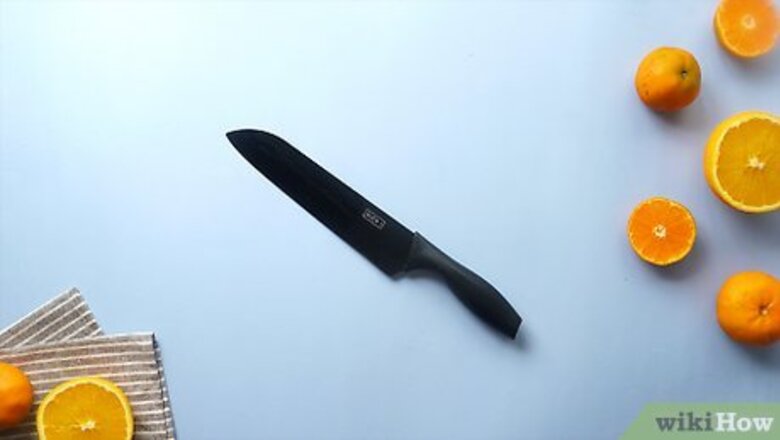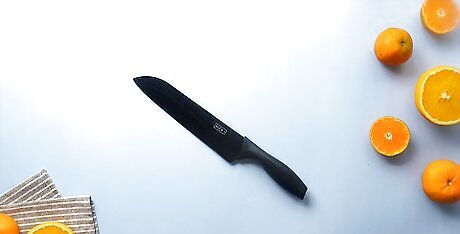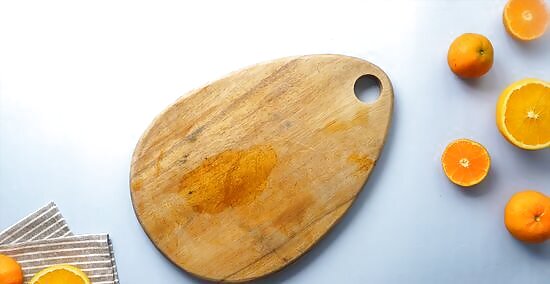
views
Cutting off the Pith

Grab a sharp knife. Choose a knife that has a sturdy blade instead of a flexible one. If the knife bends at all, it will make cutting through the orange peel harder. Make sure your knife is sharp so it easily slices through the tough skin of the orange. A paring knife or a larger carving knife works well. Don't use a chopping knife because the flat cutting edge of the knife makes it harder to use. To test the knife, try to slice into the fruit's skin. If the knife doesn't slice easily, get a sharper one or sharpen the knife.

Set a cutting board or mat on a flat surface. Cut the orange on the counter or table if you can. Cutting on a sturdy surface is easier than cutting the orange in your hand. Be sure to use a cutting surface so you don't cut into your countertop or table. If you have a counter made for cutting, or you don't mind nicks, the cutting board is not absolutely necessary.

Slice the top and bottom off of the orange. Lay the fruit on its side. Use the knife to slice a circular wedge off of the top and bottom. Cut deep enough into the orange that you reveal a portion of the flesh, but not so deep that you cut off a lot of the flesh. If your knife is sharp enough, you'll be able to slice straight through the peel. If the knife is a bit dull, spin the orange as you cut until you remove the slice.

Cut a slice of the peel off. Set the orange on its flat top or bottom. Position your knife on top of the orange so the knife is horizontal. Slice downward under the peel and pith until you reach the bottom of the fruit. Be sure to follow the curve of the orange so you slice under the pith. Make the slice about one inch (2.5 cm) wide, depending on how large your knife is. Don't cut so deep into the fruit that you remove more than a sliver of the flesh.

Continue slicing off the peel around the orange. Use the same downward curving slice to remove sections of peel from the orange. Make sure you slice just between the pith and the flesh. It's okay if you leave small pieces of pith or cut a little deeper into the flesh and leave no pith. The pith is white, smooth, and somewhat spongy. If you notice some of this staying on the orange as you cut, begin to cut a bit deeper.

Cut or scrape off the remaining pith. You've sliced off the majority of the pith, but there may be bits left. Use the knife or your fingernail to gently scrape off those remaining slivers of pith. Discard all of the pith and peel, unless you want to use them for another purpose.
Boiling Oranges to Remove the Pith

Place the orange into a pot of boiling water. Put a small or medium pot of water on the stove, and start it boiling. When the water boils, carefully set the orange into the boiling water. Don't drop the orange or you risk splashing boiling water on yourself.

Let the orange sit for about ten seconds and remove it. Use a metal or heat-safe spoon to bob the orange around in the boiling water. After ten or less seconds, scoop the orange out with the spoon. Set it on the counter to cool.

Make four vertical slices into the peel around the orange. After the orange has cooled for a few minutes and isn't hot to the touch, use a sharp knife to slice the peel. Slice into the orange from the top to the bottom. Make four vertical cuts, evenly spaced around the orange.

Pull the peel off and remove any pith pieces. Slide a finger under a section of peel and remove it from the orange. Perform this same task for each of the four sections of peel. Discard the peels or save them to use for another purpose.

Scrape or cut off small pieces of pith. Use a sharp knife or your fingernail to gently scrape off any slivers of pith that may not have come off with the peel. Since the boiling water softens the peel, most of the pith will stay attached to the peel and come off easily.



















Comments
0 comment